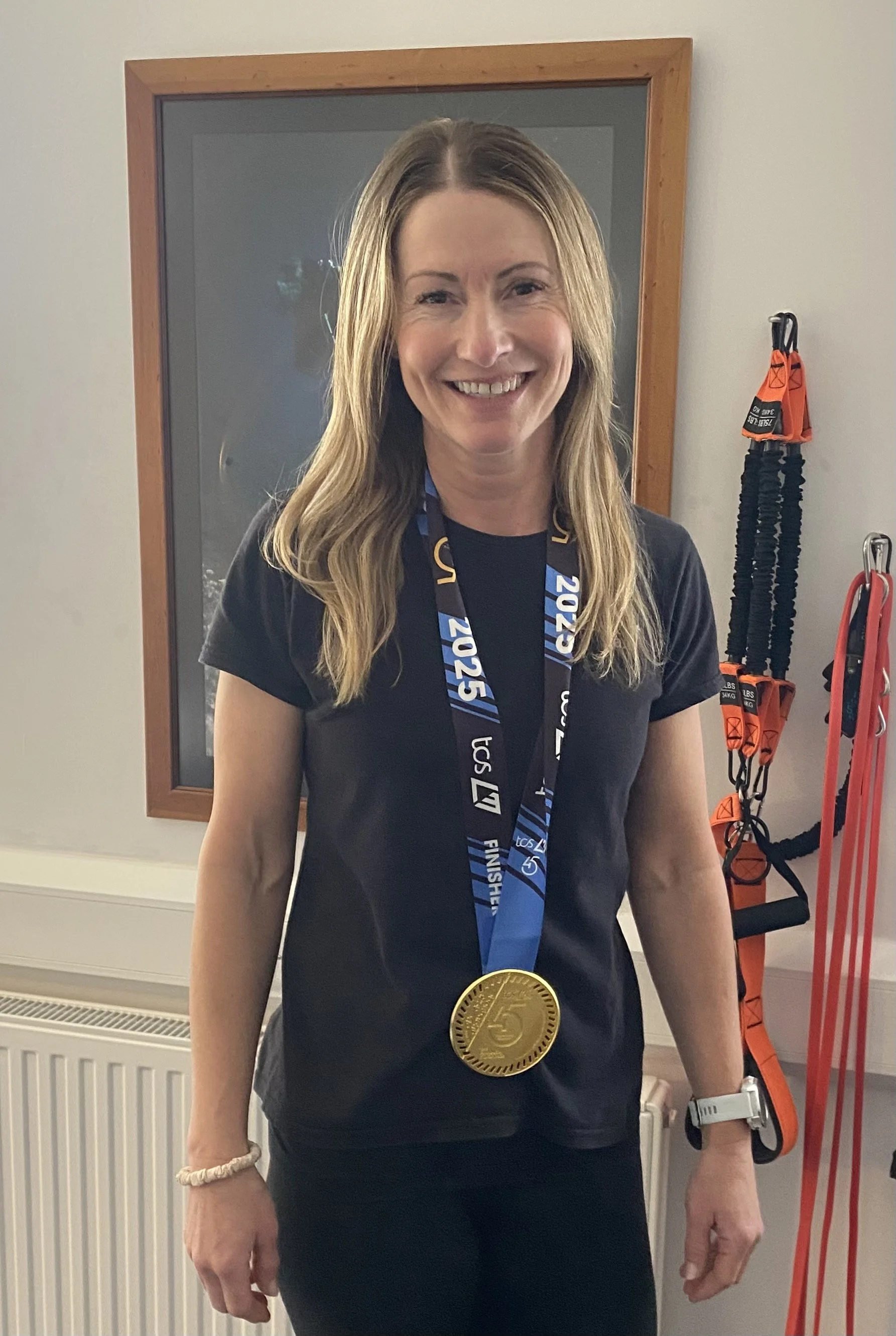
may 2025 Newsletter.
Welcome to our newsletter, with all our updates and some helpful resources for you. In May’s edition we talk about the glutes!
Remember, we are here to help you and you can contact us anytime.
Welcome to our
MAY newsletter
Hello friends of Ocean Therapy. Welcome to our May newsletter!
Happy May, welcome to your monthly Ocean therapy update and educational newsletter.
We are currently bathing ourselves in quite unseasonable very warm weather, some of you may have experienced this last weekend whilst participating or supporting family or friends at the Prestigious 45th London Marathon, apparently it was recorded as the 4th hottest since records began.
We have a couple of special friends of Ocean Therapy who participated on Sunday and we would like to congratulate them on their amazing achievements. Josie Wait who some of you may know well from Sandfoot castle and Jenna Stone who worked hard through a chronic injury to complete the gruelling 26.2 miles in 20 degrees of sun and in the meantime managed to raise a substantial amount for her chosen charity very close to her heart, the pancreatic cancer trust. Jenna sadly lost her dad a few years ago to this and decided as a keen runner she would dedicate her miles to this very worthy charity. If you would like to sponsor Jenna (donations still gladly accepted) then please see the following link.
Josie is also competing in the local North Dorset marathon this weekend to attempt to break a new PB…. Go girl we look forward to hearing all about it!
I also reached a personal milestone this last month and got out on my mountain bike for over 2 hours…. A personal achievement having not been on my bike since October 24 and since my hip replacement. It was great to be back in the saddle and what a day to get out, beautiful warm day lots of sunshine and dry fields what’s not to like!!!
For those that don’t mountain bike, no fear! May marks national walking month so get those walking shoes on and get walking, just 30 minutes a day will give you so many benefits, for example an improved cardiovascular health. Walking strengthens your heart and lungs reducing the risk of heart disease, stroke and high blood pressure. Regular walking helps to lower LDL (the ‘bad’ cholesterol) and raise the HDL (the ‘good’) cholesterol, besides heart disese and stroke, regular walking has been linked to a reduced risk of type 2 diabetes, some types of cancer. Walking is a weight bearing exercise that helps to strengthen your bones, reducing the risk of osteoporosis, and strengthening your muscles.
Engaging in regular physical activity like walking can also improve your sleep quality, it will improve balance and coordination, it’s great for reducing stress and anxiety and any symptoms of depression, did you know by just walking 30 mins a day can reduce the chance of dementia by to 30%! Cytoplan the supplement provider we use here at Ocean Therapy are currently running a ‘walk to wellness’ walking challenge to mark national walking month, lots of great prizes up for offer please see the attached link.
Boris’s Update:
After 10 years of racing full ironmen distance triathlons, including 8 full and 6 half events, I have decided to step back from that chapter. It’s been an incredible journey of endurance, discipline and discovery.
However the journey dosen’t stop, these days, I find my peace and passion in the sea, swimming daily for the past 5 years. This year Claire my wife and myself will be taking part in the swim serpentine in London in support of MS UK. Over the last 25 years , I have had the priviledge of helping many clients living with MS, this is a cause close to our hearts.
If you would like to support or learn more, we would love to have you along for the next part of the journey.
It’s all about the Glutes!
This month we are going to look at why it is so important to have gluteal muscles (or hip abductor) muscles that are strong and active. In previous newsletters we have discussed low back pain and hip pain. In this edition we are going to get a little more specific and discuss these muscles that are key to preventing back and hip pain.
Meet your glute Medius and Minimus
Think of your buttock muscles as a team. You’ve probably heard of gluteus maximus, which is the largest, and most powerful, mainly responsible for large movements like standing up and climbing the stairs.
Now let’s concentrate on its smaller relatives but key to pelvic stability the Gluteus Medius and the gluteus Minimus.
The Gluteus Medius
This is this as a medium sized fan shaped muscles on the outer surface of your upper buttock.
The Gluteus Minimus
This is the smallest and lies underneath the gluteus Medius, closer to your hip joint, think of them as being ‘on the side’ of your hips not at the back like the maximus.
How they stabilise your pelvis: the balancing act!
Now how do these muscles keep our pelvis steady? When it comes to injury prevention, and rehabilitation especially around the low back, pelvis and hips strengthening the right muscles can be the difference between a short-term recovery and on-going issues. These two overlooked muscles play a small but vital role I stabilising the lumbo pelvic hip complex, this is the intricate system that controls how your spine, pelvis and hips move effectively together allowing for the freedom of movement. Think of them as the body’s own natural shock absorbers, they help to keep your pelvis level during movement, support healthy gait patterns, strain on the lumbar spine and avoid long term painful low back pain and hip issues. Why these muscles matter in rehab:
Weakness in the gluteus Medius or minimus can lead to a pelvic drop (often seen in gait dysfunctions we call it a ‘Trendelenburg gait’ which increases stress on the lower back, and knees. (more about that later)
Load Distribution- Efficient activation of these muscles helps distribute load evenly through the hip and knee joint rather than overloading compensatory structures like the spine, Sacro iliac spine or hamstrings
Injury Prevention-Strengthening these muscles are essential for preventing common injuries like lower back pain, IT pain, piriformis syndrome, ankle instability, knee pain and even disc problems of the spine.
Optimized movement patterns-
Rehabilitation exercises isn’t just about healing an injury-it’s about moving better afterwards -strong glutes encourage correct alignment and fluid, pain free movement.
OK so what happens when they get weak?
Compensation patterns start to creep in, other muscles often the hamstrings lower back extensors and the hip flexors take over, leading to shortening, tightness fatigue and eventually new areas of pain and injury. Left unaddressed, a weak glute med or min can create a domino effect up and down the kinetic chain.
We have attached some patient resource sheets with key exercises to this newsletter for your information, these will promote activation, stability and control, helping you to remain functional and pain free. The video’ below demonstrate banded side walks and one legged step downs, the side walks provide constant lateral flexion, whilst both exercises encourage correcting muscle imbalances and ultimately strengthening those gluteals. On a recent challenging walk from Ringstead to Osmington Mills I navigate myself with my dog Lucy over large rocky boulders at low tide I may add!!
When performing these exercises focus on proper form, controlled movement and muscle engagement rather than simple rushing through the sensuality over quantity is always key!
The bottom line (pardon the pun!) if you are rehabbing an injury, or aiming to future proof your body against one don’t overlook the gluteus Medius and minimus. Their role in stabilising the lumbo-pelvic hip complex is fundamental to efficient, pain free movement. Your rehab isn’t just about getting back on your feet- it’s standing stronger than ever. For the patient resources please look below






